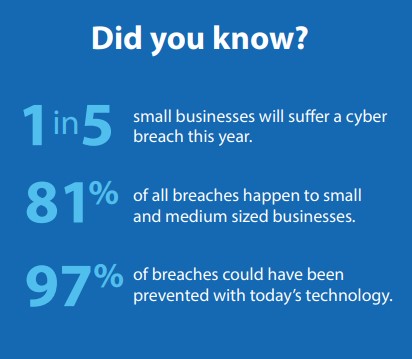10 Ways to Protect Your Business From a Cyberattack
1. Security Assessment It's important to establish a baseline to see what your current vulnerabilities are. Once your ...
1. Security Assessment
It's important to establish a baseline to see what your current vulnerabilities are. Once your MSP, (Managed service provider) conducts the assessment they can close any existing holes and work to strengthen your protection. When we run assessments for businesses, the business owner is usually shocked at what we find. When was your last security or network assessment? Take the next step and let us evaluate your digital risk and protect your business with a complimentary cybersecurity risk assessment.
2. Secure Your Email
Most attacks originate in your email. Your MSP should put layers in place to reduce spam and your exposure to attacks in your team through email.
3. Cybersecurity Policy
Apply policies for your business such as enabling strong passwords and changes, set user screen timeouts, limit user access and deny or limit USB file storage access. Need help creating a policy? We have a free cybersecurity policy template to get you started.
4. Security Awareness and Phish Testing
Train yourself and your staff, and do it regularly. Teach them about data security, policies and procedures and email attacks. "Phish" yourself and your employees. We send out weekly phishing emails to our clients that offer training tips if you click on a link or open attachments in one of our emails. It not only trains you on what to look for, it also keeps being diligent and safe at the top of you and your team's minds. If you know that you are being phished, you are less likely to take the real, malicious bait.
5. Multi-Factor Authentication
Use MFA whenever you can including on your network, banking websites and even social media. It adds an extra layer of protection to ensure that event if your password is stolen, your data stays protected. Microsoft has done studies and found that MFA stops 99% of attacks on your accounts.
6. Computer Updates
Keep your PC or laptop updated, always. Keep Microsoft, Adobe, Apple and other programs updated for better security. If you have an IT team or work with an MSP like us, make sure they have your machines set up to automatically run updates and protect your computers against the latest known attacks.
7. Dark Web Scans
Knowing in real time what passwords and accounts are up for grabs on the dark web will allow you to be proactive in preventing a breach. We scan the dark web for you and take action to protect your business from stolen credentials.
8. Enterprise Level Firewall
Having the right firewall is essential for your business and the safety of your network. Not all firewalls are created equal. Make sure your IT team or MSP works with you to give you the best options in accordance to budget. Turn on intrusion detection and prevention so that your MSP can keep your network protected from unwanted traffic.
9. Encryption
Whenever possible encrypt your files, especially one that hold employee or client's private and personal data. When sending emails with personal information those should always be encrypted.
10. Backups
Backup locally and backup on the cloud. Have an offline backup for each month of the years. Test your backups often. If you're not sure if your backups are working properly, check out our blog post, how do you know your backups are working to learn more.
In conclusion, protecting your business from a cyberattack requires a proactive approach and a combination of security measures. In conclusion, protecting your business from a cyberattack requires a proactive approach and a combination of security measures. Conducting a security assessment, securing your email, implementing a cybersecurity policy, and providing security awareness training are crucial steps. Utilizing multi-factor authentication, keeping your systems updated, and monitoring the dark web for stolen credentials are also important. Investing in an enterprise-level firewall, encrypting sensitive data, and regularly backing up your files are additional measures to consider. By implementing these strategies, you can enhance the security of your business and minimize the risk of a cyberattack. To learn more about these strategies and access a helpful infographic, download our resource and start safeguarding your business today. By implementing these strategies, you can enhance the security of your business and minimize the risk of a cyberattack.
Frequently Asked Questions: Small Business Cybersecurity
Why should small businesses worry about cyberattacks?
Because attackers increasingly target small and mid-sized businesses that have valuable data but weaker defenses. A single cyberattack can cause downtime, data loss, financial damage, and reputational harm.
What is the most important first step to protect my business from cyber threats?
A key first step is knowing your risks: review your systems, data, and accounts, then close obvious gaps like weak passwords, missing updates, and lack of backups. From there, you can layer on tools like MFA, antivirus, and security training.
How do backups help during a cyberattack?
Backups let you restore your systems and data if you’re hit by ransomware, accidental deletion, or other attacks. You should keep local, cloud, and offline backups, and test them regularly to be sure they actually work.
Can I really improve cybersecurity without a big budget?
Yes. Many protections are low-cost or free: using strong unique passwords, enabling MFA, keeping software updated, training staff to spot phishing, and setting up reliable backups all dramatically reduce your risk without huge spending.
To learn about even more things you can do to protect your business from a cyberattack, download our infographic that you can share with your team.

